-10-
The Sickness Of Antisemitism
Since the days of the Patriarchs, the world has suffered a low-grade fever. At given intervals this fever has become a burning sickness inflaming peoples and nations. 1 This lingering, unexplainable, and irrational sickness was only given a name in 1879. It is called antisemitism. The disease may be defined simply as prejudice, discrimination, or persecution against the Jewish people. It has been called “…the longest and deepest hatred of human history.” 2
Obviously, the persecution of Israel was not possible before the covenant was fully established with Abraham, Isaac and Jacob. But since those ancient days, peoples and nations have come repeatedly against the people of God in order to destroy them. The Bible is replete with evidence of these attacks.
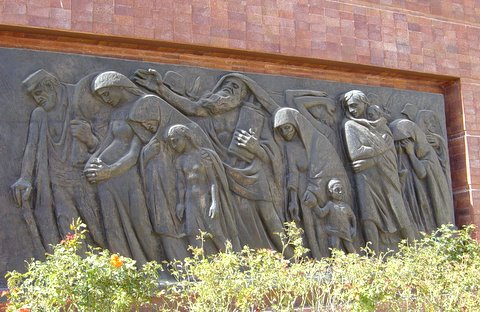
A picture of Jewish suffering at Yad Vashem in Jerusalem
ATTACKS IN ANCIENT TIMES
While sojourning in Egypt the Hebrews were mightily oppressed by Pharaoh. In his attempt to destroy God’s chosen, he commanded that all the newborn males be slain (Exo. 1:15-16). Had this plan succeeded, it would have ultimately amounted to genocide for the Hebrews.
Pharaoh oppressed and enslaved God’s people until at last they were miraculously delivered by the hand of the Almighty. After this, the Amalekites, Edomites and Moabites all oppressed Israel as she was just a newborn babe, toddling on her way to Canaan. What makes this strange, is that all these ancient peoples were actually blood relatives of
the Hebrews.
Of particular interest are the attacks of Amalek and Edom. It seems that the roots of present-day antisemitism may be traceable back in some degree to these two nations. We will speak more about these nations, but let us here consider their possible impact upon the seething antisemitism of Arab nations in the Middle East today.
The Amalekites were likely the first nation on earth to persecute Israel (Num. 24:20). As the nation of Israel was birthed from Egypt, these relatives attacked them without cause (Exo. 17:8-16). These wicked enemies preyed upon the stragglers, undoubtedly the old and infirm who were tired and weary (Deut. 25:17-18). They set ambushes for Israel (1 Sam. 15:2-3). God’s fierce wrath was therefore aroused.
Later, God sent King Saul on a special mission to avenge these hateful acts and to utterly destroy Amalek (1 Sam. 15:2-3). He disobeyed, and the seed of Amalek survived. It is ironic that Saul was later killed by an Amalekite.
God knew that the hate virus in Amalek was extremely dangerous to mankind. He therefore commanded that the whole nation be wiped off the face of the earth (1 Sam. 15:3). Centuries later in Persia, wicked Haman arose to persecute Israel. He almost put an end to the Jewish people in all 127 provinces of this vast kingdom. Persia controlled the Holy Land at that time, and had the plan succeeded, the Jews would have suffered a holocaust of incredible proportions. Jewish tradition declares that Haman was of
Amalekite origin.
The Edomites are another ancient nation needing close scrutiny in this regard. This people may also be a source of modern antisemitism in the Middle East.
The Edomites apparently received the lineage of hatred intact from their father Esau, who had sworn to kill his brother Jacob (Gen. 27:41). Edom continued the tradition of virulent hatred for Israel.
As Israel was coming out of Egypt, the Edomites refused them passage and came against them with swords (Num. 20:14-21). They later attacked Israel on several occasions and finally assisted in the destruction of Jerusalem in 586 BC. At that time they stood at the crossroads and cut down those who were escaping from the Babylonians (Obad. 1:14). It appears that this act may have sealed Edom’s doom.
But does the spirit of Edom live on? We read in scripture that the Edomites stifled all compassion. The anger of Edom “…raged continually and his fury flamed unchecked,” (Amos 1:11). Edom “…harbored an ancient hostility…” (Ezek. 35:5). All this sounds strangely familiar to the sentiments toward Israel of surrounding Arab and Muslim countries today.
In Obadiah 1:10, God says, “Because of the violence against your brother Jacob, you will be covered with shame; you will be destroyed forever.” It is surely interesting that the word for “violence” used here, is the Hebrew word “hamas.” Since a group by this very name is now one of the leading antagonists of Israel, we realize how little things seem to change over the thousands of years.
The birth of Jesus gives us a most enlightening insight into the hatred of Edom. King Herod was absolutely enraged with the news of Jesus’ birth. He even ordered the massacre of the male infants of the Bethlehem area in a vain attempt to kill the Christ child. He was determined to put a quick end to this one who was to be King of the Jews. It should not surprise us in the least to learn that King Herod was not a Jew, but was of Idumean or Edomite origin.
As proof that the spirit of Edom still lives on today in the Middle East, we should look at a strange passage of scripture in Isaiah 34:5-16. In verse eight we read: “For the LORD has a day of vengeance, a year of retribution, to uphold Zion’s cause.”
This is a future prophetic event. In this passage he tells us that Edom’s streams will be turned into blazing pitch, that her smoke will go up forever and that the land will lie desolate with no one passing through it. There is trouble coming in the future for these Israel bashers even though Edom as a nation has long since ceased to exist.
In some popular eschatology today, Edom and its city of Petra, are strongly pictured as a place of refuge for the Jews as the Day of the Lord nears. For this reason many Christian pilgrimages now include Petra. The spiritual types and patterns for this conclusion seem mistaken. The scripture makes very plain that Edom is a place of eternal cursing, not a place of refuge and blessing for God’s people.
Many of the other prophets elaborate on the Edom theme. Ezekiel speaks of Edom as harboring an ancient hatred. Then he says something that should send a shiver up the spine of all Israel bashers today.
Then you will know that I the LORD have heard all the contemptible things you have said against the mountains of Israel… (Ezek. 35:12)
We understand by this statement that the God of the Universe still hears all the slanders that nations speak against Israel today. He still hears all the slanders spoken by writers and newscasters, and he will recompense them all.
The Messiah at his coming will deal harshly with Edom, or with its spiritual descendants, whoever, and wherever they are. This account is found in Isaiah 63. In this passage we see the Messiah’s garments stained with blood. By his own confession he says:
“I have trodden the winepress alone; from the nations no one was with me. I trampled them in my anger and trod them down in my wrath; their blood spattered my garments, and I stained all my clothing (Isa. 63:3).
The Messiah at his coming seems amazed at the nations that there was no one who gave support (v.5). Perhaps the nations and even the Church have been too busy trying to justify and support the enemies of Israel to realize that these modern enemies of that nation may well be God’s enemies just as they were in biblical times.
We should learn one thing from the Amalek and Edom episodes in the Bible. When God decrees that a nation should be destroyed, we had better believe that such destruction is absolutely necessary.
LATER ATTACKS
Once they were in the land of Canaan, the attacks against tiny, struggling Israel were virtually endless. The long centuries were filled with wars brought about by all the surrounding nations. Time and again the Edomites, Moabites, Amalekites, Ishmaelites, Ammonites, Midianites, and Philistines came against the people of God.
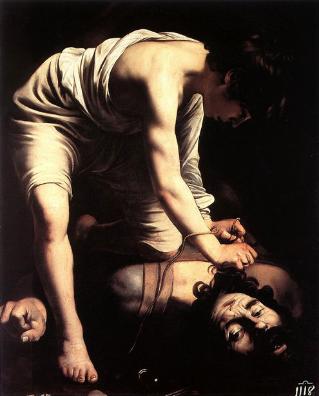
David and Goliath by Caravaggio
(Wikimedia Commons)
The persistent attacks upon Israel made no sense. King David often wondered about them. He could never understand why he had so many enemies. One other Psalmist certainly wondered about them. We have his recorded musings in Psalm 2:1-3. Although this Psalm speaks primarily about the Lord and his Messiah, we can see why it would also apply to the Jews and their law:
Why do the nations conspire and the peoples plot in vain? The kings of the earth take their stand and the rulers gather together against the LORD and against his Anointed One. “Let us break their chains,” they say, “and throw off their fetters.”
The presence of the Jewish people in the world brings fetters to those who are lawless. These chains represent law, righteousness and holiness. The world wants none of these things, but instead desires to cast off these “chains” of Israel.
There is another and much deeper reason behind antisemitism. Antisemitism has behind it the secret mystery of iniquity. It is a part of Satan’s diabolical plan to come against the heritage and the people of God. Thus, antisemitism is anti-God and anti-Christ in its essence.
Throughout the painful saga of Israel’s history she was also bitterly attacked by the stronger empires in the area, such as the Egyptians, Assyrians, Babylonians, Greeks, and finally the Romans. The attacks of Antiochus IV (Epiphanes) during the Greek era had such demonic overtones that Antiochus became a type of the Beast or antichrist ruler who would arise to persecute the Jews mightily at the end of days (Dan. 8:19-26).
The spiritual and diabolical roots of this awful disease of antisemitism are pointed out for us clearly in the book of Daniel. In Daniel 10:20, when the angel appeared to the prophet, he made an interesting comment:
…Soon I will return to fight against the prince of Persia, and when I go, the prince of Greece will come…
This mighty angel of God had been struggling with extremely powerful spiritual entities. The prince of Persia had already delayed him by twenty-one days due to his opposition. Now we learn that the prince of Greece was waiting in the corridors to take his turn at destroying Israel. We see clearly by this that the nations who oppose Israel are driven by mighty supernatural forces.
PAGAN ATTACKS
Once the nation of Israel was destroyed by the Romans, and its people dispersed in the wars of AD 70 and 135, one would think that the “Israel problem” would be put to rest, and that the world would go on to other concerns.
Such was not to be the case. The fever and agitation were unabated. Even the pagan writers of that period, such as Lysimachus, Apion, Tacitus, and Juvenal, continued to attack and slander the dispersed Jewish people.3 Riots and persecutions erupted in various cities of the pagan world.
All this could be understood much more readily than the attacks that came from another quarter — from the newly founded Christian Church.
EARLY CHRISTIANS INFECTED
Perhaps it first stemmed from jealousy or fear, or from some of both. Nevertheless, shortly after Apostolic times, the Church allowed itself to become infected with the ancient virus of antisemitism.
From the second century on, the early Church fathers such as Ignatius, Justin, Irenaeus, and Cyprian began to make inflammatory statements concerning the Jews. Their statements were made in contradiction to what seems to be clear biblical admonitions in Romans 11:17-18, and in many other passages of the New Testament.
This tendency, although mild at the outset, especially when compared with that which would come later, quickly laid the foundations for early Triumphalism. This was the idea that the Church has superseded Israel entirely.
Ignatius of Antioch may have been the first Father of the Church to slander the Jews. He wrote to the Magnesians in the early second century that “Christianity… did not believe in Judaism, but Judaism in Christianity.” 4
Ignatius lived in a time when Christianity was still closely connected to the faith of Israel. Just shortly before his days, the Apostles had celebrated Jewish feasts and kept the Jewish Sabbath. Yet Ignatius has stern words for Christians who would pattern after the Apostles. He remarked:
If anyone celebrates the Passover along with the Jews, or receives emblems of their feast, he is a partaker with those that killed the Lord and His apostles.5
Later, Justin Martyr (100-165? AD) in his lengthy Dialogue with Trypho, said of Trypho the Jew, “You hate and (whenever you have the power) kill us” 6 Justin also in speaking of the writings of Moses said to Trypho:
They are contained in your Scriptures, or rather not yours, but ours. For we believe them; but you, though you read them, do not catch the spirit that is in them. 7
Justin also remarked:
For the prophetical gifts remain with us, even to the present time. And hence you ought to understand that [the gifts] formerly among your nation have been transferred to us. 8
Later, Irenaeus, Bishop of Lyon (AD 130-202), declared the Jews “disinherited from the grace of God.” 9

St. Irenaeus
(From Wikimedia Commons)
Beginning as early as the days of Justin Martyr there had been a continuing dispute between Christians in the eastern and western areas of the Roman Empire. This dispute concerned the proper date for the observance of Easter. The disagreement became so acute about 190 that synods were held both in the east and in the west.
The decision was finally made in favor of the western Roman custom and against the ancient custom of celebrating Easter with the Passover. The churches of Asia Minor refused to accept this decision, whereupon Victor, the Bishop of Rome, excommunicated Polycrates, bishop of Ephesus. 10 It was a precedent favoring Roman understandings and practices that would bode ill for future Church decisions.
The trend toward Triumphalism continued. Cyprian, Bishop of Carthage (ca. 200-258) was bold enough to demand that all Jews leave his diocese or die. 11 We can see that in a very short time, Triumphalism had taken on deadly proportions.
CONSTANTINIAN CHRISTIANITY
The fourth century was a critical one for establishing the nature of all future Christian antisemitism. Constantine, the new Roman emperor, declared himself a Christian. There is some question as to just how deeply Constantine’s Christianity ran. He continued to use the pagan title Pontifex Maximus on his coins. He also used images of some of the pagan gods, along with the Unconquered Sun, his own favorite deity. In 321, Constantine made the first day of the week a holiday. He named it for his deity, Sunday. 12
In the year 325, the first general council of the Church was called together to deal with the heresy of Arianism and to finally establish a uniform date for Easter. Constantine, the new “Christian” emperor exerted great influence upon this council. The resulting work, the famous Nicene Creed, was defined and accepted. The Church also moved to distance itself from Judaism in regard to the celebration of the Lord’s resurrection. Constantine’s letter to the churches is very instructive concerning the spirit of this council. In his letter he referred to the Jews as “…polluted wretches…blinded in their minds…(a) most odious fellowship…parricides and murderers…” 13
Constantine made clear the intent of this council by quickly forbidding Jews to proselytize. He also forbade them to live in their own city, Jerusalem. 14
Following in the spirit of Nicea, John Chrysostom (349- ca 407), one of the most popular preachers of these times, began his tirades against the Jews. Chrysostom was such a persuasive preacher that he was labeled the “Golden Tongue.” In a series of eight sermons he used his golden tongue to attack the Jews. Chrysostom called the Jews “most miserable of all men” “lustful, rapacious, greedy perfidious bandits.” He described them as having “the manners of the pig and the lusty goat.” He said “they have surpassed the ferocity of wild beasts, for they murder their offspring and immolate them to the devil.” Chrysostom went on to say, “…I hate the Jews also because they outrage the law…” 15
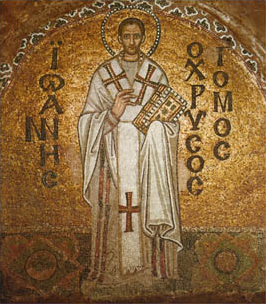
John Chrysostom, a Byzantine mosaic from the
Hagia Sophia (Wikimedia Commons)
“The language of antisemitism is the devil’s native tongue; it quickly becomes the second language of the devil’s disciples, and soon it takes command of their original language…(the Devil) is the god of antisemitism. “16
At the end of his sermon series, Chrysostom demanded that his hearers pay him interest, apparently meaning that they go out and do something to actually persecute the Jews. 17
The questionable teachings offered by these early fathers and preachers continued to inflame the Church in its formative centuries. Church and state also were now working hand and hand toward the systematic isolation and persecution of the Jews.
Following the example of Constantine, Emperor Constantius set a pattern by confiscating the property of a Christian who dared convert to Judaism. 18 In following years, the Byzantines disrupted synagogue services and forbade Jews to hold governmental posts. Jews were not permitted to beautify or repair their synagogues without permission. They were barred from public functions. Marriage of Jews to Christians was seen as “shameful,” and such marriages were prohibited under penalty of death. 19
Later Byzantine rulers such as Heraclius, Leo III, and Basil I promoted forced conversions of the Jews. The trend went on in both the eastern and western portions of the empire. In the west, sixth and seventh century Frankish kings, such as Chilperic I and Dagobert I, also promoted forced conversions and baptisms.20
THE CRUSADES
Soon after the end of the first millennium a crowning tragedy developed for the Jews. It came as a result of agitation caused by the Crusades. This tragedy began shortly after the Council of Clermont in 1095, and lasted almost two hundred years. In this council, the Pope called for crusades to liberate the Holy Land from the hand of the Muslims.
At the beginning of the First Crusade, restless adventurers started testing their swords on the Jews in their midst. In many cities such as Speyer, Worms, Cologne, and Prague, the Jews were massacred. It is estimated that from January to July in 1096, some 10,000 Jews died. This would have probably amounted to about one fourth to one third of the Jewish population of Germany and Northern France. 21
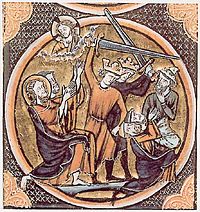
French Bible illustration from 1250 depicts
Jews being massacred by Crusaders
(Wikimedia Commons)
When the Crusaders finally reached Jerusalem in 1099, they rounded up its remaining Jews and burned them alive in their own synagogue. While the Jews screamed in the flames, the Crusaders held their crosses high and sang “Christ We Adore Thee!” 22
Unfortunately, many more crusades were to come, and they all would tend to follow the same destructive pattern as the first.
NEW WEAPONS OF ANTISEMITISM
In the 12th and 13th centuries, the Church doctrine of Transubstantiation gained wide acceptance. This doctrine affirmed that the actual flesh and blood of Christ became present in the consecrated Host and wine. Miraculous tales in connection with the Host began to circulate and soon the Jews began to be charged with desecration of the Host.
Another common charge of the Church in this period was that the Jews kidnapped Christian children, killing and torturing them in order to obtain blood for their Passover ritual. No one seemed to know or even care that partaking of blood was totally forbidden by Jewish law, yet the myth persisted even as late as 1936 in Nazi Germany.
After each blood libel, the Church would rise up in hysterical rage to avenge itself upon the Jews. Blood libels became one of the most vicious weapons used against the Jews, and they left a trail of Jewish blood through the centuries.
Antisemitism continued to take its toll with expulsions of whole Jewish populations from many European states. In the period between the 11th and 19th centuries the Jews were expelled at least 34 times from major Christian cities and states.
| 34 Times when Jews were expelled from their homes (Often they were expelled, invited back and then expelled again) |
1012 Mainz
1182 France
1276 Upper Bavaria
1290 England
1306 France
1322 France
1394 France
1420 Lyons
1424 Cologne
1438 Mainz
1439 Augsburg
1442 Upper Bavaria
1446 Brandenburg
1462 Mainz
1483 Mainz
1483 Warsaw
1492 Spain
1492 Italy
1496 Portugal
1496 Naples
1498 Nuremberg
1510 Brandenburg
1515 Genoa
1533 Naples
1541 Naples
1541 Prague
1550 Genoa
1551 Bavaria
1557 Prague
1569 Papal States
1649 Hamburg
1669 Vienna
1744 Bohemia and Moravia
1891 Moscow 23
In the year 1215, the Church at its Fourth Lateran Council, ordered Jews to wear distinctive garments. These garments took many forms such as patches of cloth sewn to clothing or the forced wearing of funny hats.
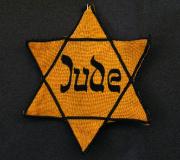
Yellow badge Star of David from the Jewish Museum Westphalia, Dorsten, Germany. The wording is the German word for Jew (Jude), written in mock-Hebrew script.
(Wikimedia Commons)
Jews were at various times forbidden to engage in trades, to own land, to intermarry with Christians, and even to live in the midst of Christians. As a final insult they were not even allowed to die in the midst of Christians, and Jewish graves were commonly desecrated.
By 1240, the Jews were forced into disputations with the Christians. As a result of these disputations, the Talmud was burned in Paris in 1242. Jews were also forced to listen to Christian sermons, a practice not abolished until 1848.
As result of the Black Death in Europe, the Jews suffered much in what are referred to as the Black Death Massacres. These massacres continued from 1348 to 1350. In this plague, the Jews were the usual scapegoat and were accused of poisoning the wells of Christians.
THE INQUISITION
The Jews had experienced a “golden age” in Spain, which produced some of the greatest poets, thinkers and inventors in the history of the country. Nevertheless, in 1391 a storm of anti-Jewish persecution swept over the nation. This storm was provoked by certain Christian preachers. As a result, thousands of Jews were killed. For the first and only time in history, the spirit of a whole Jewish people broke, and when faced with the choice of conversion or death, many chose the former.24
Churches were filled with these “new Christians.” Unfortunately, the “old Christians” now looked upon the new Jewish converts with suspicion. This was partly due to their rapid rise to important positions in the country, even into the royal court. They were soon given a name of contempt, marrano, which meant “swine.” Judaism and marranism were looked upon as having a common source – bad blood. Jews were considered perverse and defiled, whether or not they were baptized. 25
Certainly, some continued to be crypto-Jews, who secretly held on to elements of their former faith. This fact also aroused suspicion and helped hasten massive persecution.
As a result, in 1480 Pope Sixtus IV gave permission for the Inquisition to be established. With the rise of the Christian rulers, Ferdinand and Isabella to the throne, and the defeat of the Moors (Muslims), the situation rapidly turned against the Jewish population. Soon the infamous Thomas de Torquemada became the Grand Inquisitor.
Many citizens, plus a large proportion of marranos, fell into the hands of the Inquisition. The first act of the Inquisition upon arrest was generally to seize all property of the accused. This, of course did a great deal to prejudice the outcome of any trial. The accused was also forbidden to know the names of his accusers or to use a counsel for defense.
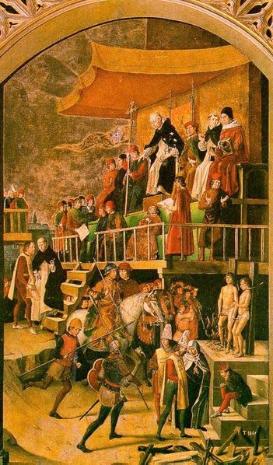
Saint Dominique presiding over an auto da fe (1475).
Image by Pedro Berruguete.
(Wikimedia Commons)
Almost any innocent act could bring down the wrath of the Inquisition upon a person or a whole family. Simply a regard for personal cleanliness, or special culinary tastes could get one accused of Judaism and cost the person’s life. The failure to wear one’s best clothes on Sunday, failure to eat pork, the lighting of candles on Friday, changing linens for Sabbath, or calling children by Old Testament names, could consign one of the flames.
The inquisition used the most cruel forms of torture to induce a confession. Roth describes some of them for us:
The commonest modes were the pulley or strappado, and the water-torment of aselli. In the former, the victim’s wrists were tied behind his back and attached to a pulley, by means of which he was hoisted from the floor. If this did not prove sufficient to make him speak, weights were attached to the feet…The water torture was more ingenious, and more fiendish. The prisoner was fastened almost naked on a sort of trestle with sharp-edged rungs and kept in position with an iron band, his head lower than his feet, and his limbs bound to the side-pieces with agonizing tightness. The mouth was then forced open and a strip of linen inserted into the gullet. Through this, water was poured from a jar (jarra), obstructing the throat and nostrils and producing a state of semi-suffocation. This process was repeated time after time, as many as eight jarras sometimes being applied. Meanwhile, the cords round the sufferer’s limbs were continually tightened until it seemed as though every vein in his body was at bursting-point. 26
When the confessions were made, the auto de fe was then arranged. There were times when as many as fifty persons were burned at the stake in one day. It was a gala event for the people and the nobility, with sometimes as many as fifty thousand spectators on hand. Not all the accused were burned at the stake. Some were reconciled to the faith. Roth states, “A man might leave the Inquisition without being burned, the proverb ran, but he was certain to be singed.” 27
From the time the Spanish Inquisition was founded to the year 1808, one estimate is that 31,912 heretics were burned. Another estimate sets the total of those burned between 1482 and 1525 at 28,540.28 This does not include the number of those burned in Portugal where the Inquisition also spread.
Both Spain and Portugal ultimately expelled their Jews. Spain expelled its Jews in 1492, as Columbus was sailing from her harbor to the new world. Expulsions continued on until 1615, with the numbers running somewhere between 300,000 and 3,000,000.
Roth adds a sad commentary: “Spain was rid at last of that section of her children who, in the ninth and tenth centuries, had raised Spanish culture to its greatest heights.” 29
MODERN ANTISEMITISM
It would relieve us somewhat if we could say that Christian antisemitism was confined only to Catholicism or to the dark ages of Christian history. Unfortunately this was not the case. Even the great 16th century reformer, Martin Luther, had a few things to say about the Jews.
What shall we Christians do with this rejected and condemned people, the Jews?…I shall give you my sincere advice. First, to set fire to their synagogues or schools and to bury and cover with dirt whatever will not burn, so that no man will ever again see a stone or cinder of them. This is to be done in honor of our Lord and of Christendom…Second, I advise that their houses also be razed and destroyed…Third, I advise that all their prayer books and Talmudic writings, in which such idolatry, lies, cursing, and blasphemy are taught, be taken from them. Fourth, I advise that their rabbis be forbidden to teach henceforth on pain of loss of life and limb… Fifth, I advise that safe-conduct on the highways be abolished completely for the Jews. For they have no business in the country-side…Sixth, I advise that usury be prohibited to them, and that all cash and treasure of silver and gold be taken from them and put aside for safekeeping…Seventh, I recommend putting a flail, an ax, a hoe, a spade, a distaff, or a spindle into the hands of young, strong Jewesses and letting them earn their bread in the sweat of their brow. 30
These were just a few of his suggestions. It is of note that Luther’s remarks were used in the defense of Nazi war criminals at the Nuremberg trials.
Antisemitism raged on in Christianity until modern times. Jews were finally placed under lock and key in the Ghetto. There were accusations, blood libels, pogroms, slanders. Early in the twentieth century there was the publication of the infamous fabrication Protocols of the Elders of Zion. The stage was being perfectly set for the most horrendous persecution of all.
THE HOLOCAUST
The bitter seed that had been sown in Christendom for almost two thousand years became ripe during the Holocaust of World War II. In the midst of enlightened Europe, even in the very cradle of the great Reformation, six million Jews were coldly and cruelly murdered while most Christians simply shrugged.

Railroads were used to transport Jews to the gas chambers.
Pictured here is a railroad car to nowhere from Yad Vashem
The Holocaust or Sho’ah began in Germany on January 30, 1933 as Adolph Hitler and his Nazi party rose to power. Hitler immediately began to implement the radical antisemitism that he had earlier expressed in his book, Mein Kampf.
First of all, the Jews were eliminated from public office, from professions, and from intellectual and artistic life. Even children were barred from public schools. The Nuremberg Laws of 1935 stripped Jews of their citizenship. There were boycotts against Jewish businesses and enforced sales of property and businesses.
On November 9-10, 1938, Kristallnacht, “the night of broken glass,” was staged by the Nazis. Jewish businesses and properties were attacked, synagogues were burned, and in the aftermath, thousands of Jews were rounded up and sent to concentration camps.
During this period, the Church in general did not raise its voice. The dissident Confessing Church did resist and many of its ministers were arrested.31 Somehow the Church had forgotten the biblical admonition to love its neighbor. It had also forgotten the admonition of Proverbs 24:10-12 which reads:
If you falter in times of trouble, how small is your strength! Rescue those being led away to death; hold back those staggering toward slaughter. If you say, “But we knew nothing about this,” does not he who weighs the heart perceive it? Does not he who guards your life know it? Will he not repay each person according to what he has done?
The Church not only remained passive to the Jewish plight, but it also on occasions assisted the Nazis. Some diocesan chancelleries actually supplied data from their church records as to the religious background of their parishioners. 32
With Hitler’s invasion of Poland in 1939, millions of Jews came under his demonic power. Jews were herded to the ghettoes and into concentration camps. At first, the Nazis envisioned total emigration of the Jewish population from Europe. Later, at least by the beginning of 1941, the decision was made for genocide.
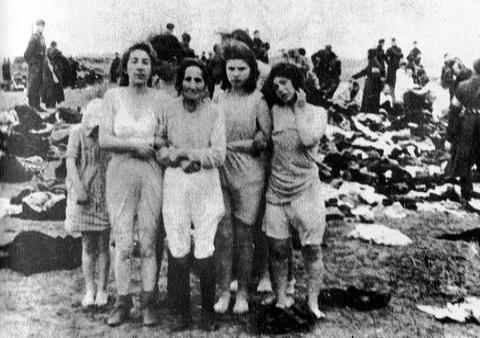
Several women and a girl in Latvia stand partially undressed, as they await the firing squad
(courtesy Yad Vashem)
When the Nazis invaded Russia, Hitler gave the order to kill all Jews as well as Communist officials. The Nazi advance into Russia trapped 1,500,000 Jews and the newly formed Einsatzgruppen, set at work on the extermination project. The grisly work was first accomplished through firing squads and mass burials. Later, gas trucks were used, and finally even these were not sufficient for the task.

Doom seems seen written on the faces of women and children at Auschwitz
(courtesy Yad Vashem)
The Nazis finally turned to extermination camps, equipped with fake shower rooms for gassing, and with giant furnaces for cremation. One such extermination camp was Auschwitz, an enormous facility in southern Poland. At this one installation, it was possible to cremate 10,000 corpses a day. A total of two million Jews died there. Because of the brutality in the camp, many of the Jews died before they reached the gas
chambers. 33
The Nazis made a very thorough sweep of Jews in the areas of their control. Johnson remarks:
There were about 8,861,800 Jews in the countries of Europe directly or indirectly under Nazi control. Of these it is calculated that the Nazis killed 5,933,900, or 67 percent. In Poland, which had by far the largest number, 3,300,000, over 90 percent, were killed. 34
As six million Jews died in the Holocaust most nations of the world turned their heads. Great Britain, a supposedly Christian nation, had already aided Hitler by closing the doors to Palestine. The Jews were thus locked out of their homeland.
Even Christian America, although it knew of the gassing of millions of Jews, would not intervene to bomb the facilities. Nor would America raise its stingy immigration quotas. On one occasion the SS St. Louis with 907 Jewish passengers tried to enter US waters. It was turned away. Even “Christian” America shut its eyes and sent these Jewish refugees back to the gas chambers. Based on the actions of America and other “Christian” nations, Goebbles could write in his diary, “I believe both the British and the Americans are happy that we are exterminating the Jewish riff-raff.” 35
Some countries did help the Jews. Denmark refused to cooperate with the Nazis and saved 99 percent of its 7,000 Jews. The people of Holland saved thousands of Jews by hiding them in their homes. The late Christian leader, Corrie Ten Boom, who wrote The Hiding Place, had a part in this great effort. 36
The Holocaust, more than any other event in history, illustrates for us the demonic and other-worldly aspect of antisemitism. For instance, the trains carrying Jews to their death in Nazi Europe were given priority over everything else, even during the Russian offensive when every train was desperately needed. 37 Although Hitler was conducting a war on many fronts, this illustrates that his most important war was the one against Israel. It also again vividly illustrates the true nature of the awful sickness of antisemitism.
SYMPTOMS STILL PERSIST TODAY
One would think that after the horrors of the Holocaust, the world in general and Christians in particular would have learned about the evils of antisemitism and would have eradicated it.
Strangely though, even today in the modern Church and in the “enlightened” modern world, the disease of antisemitism still persists and even flourishes.
Now that the Jewish people are being re-gathered to their land, antisemitism often takes the form of anti-Zionism, of anti-Israel or pro-Arab sentiment. One can note this trend by the numerous times Israel is condemned in the press or on TV, or the times she has been censured by the United Nations.
Israel, whose population constitutes only one-thousandth of the world’s total, has been the object of an amazing one-third of all UN Security Council resolutions. This international “Israel bashing” reached one of its zeniths in 1975 when the UN declared Zionism to be racism. In effect, it declared illegal the biblical hope of returning to Zion. This hope had been nurtured through the ages, both by Israel and by many in the Church. Fortunately, this resolution was rescinded a few years after it was passed.
As the Jewish people return to their ancient home and become more and more concentrated in their land, this trend toward anti-Zionism will undoubtedly increase.
The prophet Zechariah declares that someday all the nations of the earth will be whipped into one last frenzy and will surround the tiny nation of Israel in order to take care of this “problem” once for all (Zech. 14:1-3). At that point God himself will personally intervene and demonstrate to the nations their folly.
We would think that surely now the Church would separate itself from this madness. Yet, even today in the modern Church there remains a persistent coolness and an unexplainable hardness toward the Jewish people and toward the nation of Israel.
Various new strands of Triumphalism, today named Replacement Theology or Restoration Theology are on the upswing. Although it seems almost incomprehensible, some Christian groups in recent years even have gone so far as to express open support for the PLO. How could such attitudes prevail in light of biblical teaching?
Perhaps my query in this regard is summed up best in these simple lines written by two different people. The first part was written by William Norman Ewer, a British writer. Later the sequel was written by Cecil Brown, an American businessman. The little
lines go:
How odd
Of God
To choose
The JewsBut not so odd
As those who choose
A Jewish God,
But spurn the Jews 38
STUDY QUESTIONS:
Who were the first people to persecute the Jews after they became a nation? Why was this ironic?
Was it fair for God to curse Amalek and to order the obliteration of that nation? What would have likely happened if he had not done so?
In what way does the hatred of Amalek and Edom possibly live on today?
Briefly describe how the tiny and seemingly harmless seed of antisemitism grew from the days of the church fathers, through the era of Constantine and into the Middle Ages.
How did the new church doctrine of transubstantiation become a threat to the Jewish people?
Can you name two church-sponsored persecutions of the Jews?
A great teacher or leader may be correct in many beliefs but wrong in others. What great church leader illustrates this fact?
What was the basic sin of the church during the Holocaust?
Now that the Holocaust is over and the nation of Israel is established, how does antisemitism best express itself?
NOTES
1. See Jim Gerrish, “The Sickness of antisemitism,” Jerusalem Prayer Letter, July, 1991.
2. Edward H. Flannery, The Anguish of the Jews, Twenty-Three Centuries of Antisemitism (Mahwah, New York: Paulist Press, 1985) p. 285.
3. Goeffrey Wigoder, ed., Encyclopedia Judaica, vol. 3 (Jerusalem: Keter Publishing House Jerusalem, Ltd., 1971-72) pp. 95-96.
4 .Quoted in, Flannery, The Anguish of the Jews, Twenty-Three Centuries of Antisemitism, p. 35.
5. David A. Rausch, A Legacy of Hatred: Why Christians Must Not Forget the Holocaust (Chicago: Moody Press, 1984), p. 20.
6. Quoted in, Flannery, The Anguish of the Jews, Twenty-Three Centuries of Antisemitism, p. 35.
7. Quoted in, Rausch, A Legacy of Hatred: Why Christians Must Not Forget the Holocaust, p. 21.
8. Quoted in, Rausch, A Legacy of Hatred: Why Christians Must Not Forget the Holocaust, p. 21.
9. Rausch, A Legacy of Hatred: Why Christians Must Not Forget the Holocaust, p. 22.
10. Williston Walker, A History of the Christian Church (New York: Charles Scribner’s Sons, New York, 1959) pp. 61-62.
11. Rausch, A Legacy of Hatred: Why Christians Must Not Forget the Holocaust, p. 22.
12 Dr. Tim Dowley, ed., A Lion Handbook: The History of Christianity (Tring, Herts, 1977) pp. 130-131.
13. Daniel Gruber, The Church and the Jews: The Biblical Relationship (Springfield, MO: General Council of the Assemblies of God, 1991), pp. 28-30.
14. Rausch, A Legacy of Hatred: Why Christians Must Not Forget the Holocaust, p. 23.
15. Quoted in, Flannery, The Anguish of the Jews, Twenty-Three Centuries of Antisemitism, pp. 50-52.
16. Quoted in, Michael L. Brown, Our Hands are Stained With Blood, The Tragic Story of the “Church” and the Jewish People (Shippenburg, PA: Destiny Image Publishers, 1992), pp. 50-51.
17. Rausch, A Legacy of Hatred: Why Christians Must Not Forget the Holocaust, p. 25.
18. Rausch, A Legacy of Hatred: Why Christians Must Not Forget the Holocaust, p. 23.
19. Flannery, The Anguish of the Jews, Twenty-Three Centuries of Antisemitism, p. 58.
20. Goeffrey Wigoder, ed., Encyclopedia Judaica, v. 7 (Jerusalem: Keter Publishing House Jerusalem, Ltd., 1971-72), p. 9.
21. Flannery, The Anguish of the Jews, Twenty-Three Centuries of Antisemitism, p. 93.
22. Rausch, A Legacy of Hatred: Why Christians Must Not Forget the Holocaust, p.27.
23. Richard Siegel and Carl Rheins, The Jewish Almanac (New York: Bantam Books, Inc., 1980), pp. 127-129.
24. Cecil Roth, The Spanish Inquisition (New York: W.W. Norton & Company, 1964),
pp. 22-23.
25. Flannery, The Anguish of the Jews, Twenty-Three Centuries of Antisemitism, p. 136.
26. Roth, The Spanish Inquisition, p. 95.
27. Roth, The Spanish Inquisition, p. 107.
28. Roth, The Spanish Inquisition, p. 123.
29. Roth, The Spanish Inquisition, p. 161.
30. Quoted in, Rausch, A Legacy of Hatred: Why Christians Must Not Forget the Holocaust, p. 29.
31. Goeffrey Wigoder, ed., Israel Pocket Library, Holocaust (Jerusalem: Keter Publishing House Jerusalem Ltd., 1974), p. 13.
32. Wigoder, ed., Israel Pocket Library, Holocaust, p. 137.
33. Flannery, The Anguish of the Jews, Twenty-Three Centuries of Antisemitism, p. 223.
34. Paul Johnson, A History of the Jews (New York: Harper & Roe, 1987) p. 497.
35. Quoted in, Johnson, A History of the Jews, p. 503.
36. Flannery, The Anguish of the Jews, Twenty-Three Centuries of Antisemitism,
pp. 149 -151.
37. Paul Johnson, A History of the Jews, p. 490.
38. The Macmillan Dictionary of Quotations (New York: Macmillan Pub. Co., 1987), p. 294.

